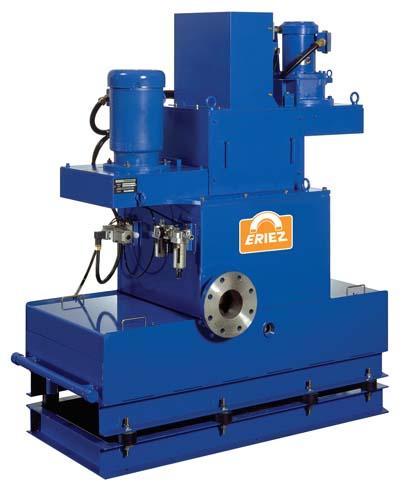
Metal chips and fines that collect in machine tool sumps and large central systems can now be effectively removed with Eriez Hydroflow's Solids-from-Liquid Centrifuges using media free filtration. Unwanted solids have a detrimental effect on coolant performance and longevity and cause lost production when removed by traditional methods. The presence of chips and fines in a sump or system can cause corrosion via galvanic reaction, making it necessary to continuously remove the unwanted contaminant without delaying a plant's operation.
Solids-from-Liquid Centrifuges from Eriez Hydroflow are specifically engineered for heavy-duty industrial applications and offer years of trouble-free operation. These units are designed for a wide variety of operations, including machining, grinding and sawing, water jet cutting, de-scaling, precious metals recovery, rolling and tube mills, parts washers and many more.
Many companies prefer to remove solids on a continuous basis without the need for disposable media. These companies can benefit from the Solids-from-Liquid Centrifuges, which provide continuous media free filtration to remove solids from their industrial fluids.
Solids-from-Liquid Centrifuges are available in manually cleaned basket style (complete with reusable liner) or fully automatic self-cleaning designs for dependable, easy to maintain, media-free filtration solutions. Whether used on a single machine, a component, or as a supplement to a complete paper media filtration/recycling system, Eriez' Solids-from-Liquid Centrifuges can remove solids typically missed by barrier filtration and reduce or eliminate costly filter paper, bags and cartridges--all of which require disposal.
Contact Details
Related Glossary Terms
- coolant
coolant
Fluid that reduces temperature buildup at the tool/workpiece interface during machining. Normally takes the form of a liquid such as soluble or chemical mixtures (semisynthetic, synthetic) but can be pressurized air or other gas. Because of water’s ability to absorb great quantities of heat, it is widely used as a coolant and vehicle for various cutting compounds, with the water-to-compound ratio varying with the machining task. See cutting fluid; semisynthetic cutting fluid; soluble-oil cutting fluid; synthetic cutting fluid.
- grinding
grinding
Machining operation in which material is removed from the workpiece by a powered abrasive wheel, stone, belt, paste, sheet, compound, slurry, etc. Takes various forms: surface grinding (creates flat and/or squared surfaces); cylindrical grinding (for external cylindrical and tapered shapes, fillets, undercuts, etc.); centerless grinding; chamfering; thread and form grinding; tool and cutter grinding; offhand grinding; lapping and polishing (grinding with extremely fine grits to create ultrasmooth surfaces); honing; and disc grinding.
- recovery
recovery
Reduction or removal of workhardening effects, without motion of large-angle grain boundaries.
- sawing
sawing
Machining operation in which a powered machine, usually equipped with a blade having milled or ground teeth, is used to part material (cutoff) or give it a new shape (contour bandsawing, band machining). Four basic types of sawing operations are: hacksawing (power or manual operation in which the blade moves back and forth through the work, cutting on one of the strokes); cold or circular sawing (a rotating, circular, toothed blade parts the material much as a workshop table saw or radial-arm saw cuts wood); bandsawing (a flexible, toothed blade rides on wheels under tension and is guided through the work); and abrasive sawing (abrasive points attached to a fiber or metal backing part stock, could be considered a grinding operation).

